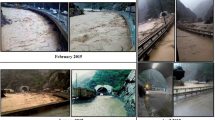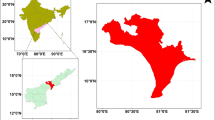Abstract
Flash floods are among the most severe hazards which have disastrous environmental, human, and economic impacts. This study is interested in the characterization of flood hazard in Gabes Catchment (southeastern Tunisia), considered as an important step for flood management in the region. Analytical hierarchy process (AHP) and geographic information system are applied to delineate and characterize flood areas. A spatial database was developed based on geological map, digital elevation model, land use, and rainfall data in order to evaluate the different factors susceptible to affect flood analysis. However, the uncertainties that are associated with AHP techniques may significantly impact the results. Flood susceptibility is analyzed as a function of weights using Monte Carlo (MC) simulation and Global sensitivity analysis. AHP and MC–AHP models gave similar results. However, compared to AHP approach, MC–AHP confidence intervals (95%) of the overall scores had small overlaps. Results obtained were validated by remote sensing data for the zones that showed very high flood hazard during the extreme rainfall event of June 2014 that hit the study basin.








Similar content being viewed by others
References
Abida H, Ellouze M (2008) Probability distribution of flood flows in Tunisia. Hydrol Earth Syst Sci 12:703–714. doi:10.5194/nhess-12-703-2008
Ascough JC, Maier HR, Ravalico JK, Strudley MW (2008) Future research challenges for incorporation of uncertainty in environmental and ecological decision-making. Ecol Model 219:383–399. doi:10.1016/j.ecolmodel.2008.07.015
Banuelas R, Antony J (2004) Modified analytic hierarchy process to incorporate uncertainty and managerial aspects. Int J Prod Res 42:3851–3872
Bellman RE, Zadeh LA (1970) Decision making in a fuzzy environment. Manag Sci 17:141–164
Bourges J (1974) Aperçu sur l’hydrologie du centre sud Tunisien: Réseau d’observations et crues exceptionnelles. O.R.S.T.O.M, Tunisie, pp 1–163
Cao C, Wang Q, Chen J, Ruan Y, Zheng L, Song S, Niu C (2016) Landslide susceptibility mapping in vertical distribution law of precipitation area: case of the Xulong hydropower Station reservoir, Southwestern China. Water 8:270. doi:10.3390/w8070270
Chen Y, Yu J, Khan S (2010) Spatial sensitivity analysis of multi-criteria weights in GIS-based land suitability evaluation. Environ Model Softw 25(12):1582–1591
Chen B, Jing L, Zheng JS, Li P (2011) Integrated management of nonpoint source pollution in the City of Chongzhou, China. In: Technical rep: prepared for the water governance program of United Nations Development Program (UNDP), Beijing, China
Coates G, Rahimifard S (2009) Modelling of post-fragmentation waste stream processing within UK Shredder facilities. Waste Manag 29:44–53. doi:10.1016/j.wasman.2008.03.006
Cova TJ (1999) GIS in emergency management. In: Longley PA, Goodchild MF, Maguire DJ, Rhind DW (eds) Geographical information systems: principles, techniques, applications and management. Wiley, New York, pp 845–858
Dahri N, Ellouze M, Atoui A, Abida H (2016) Mapping flood risk areas in Gabes basin (South-eastern Tunisia). In: International conference on applied geology and environnment ‘ICAGE’, Tunisia
Dambatta A, Farmani R, Javadi A, Evans B (2009) The analytical hierarchy process for contaminated land management. Adv Eng Inf 23:433–441. doi:10.1016/j.aei.2009.06.006
Danumah JH, Odai SN, Saley BM, Szarzynski J, Thiel M, Kwaku A, Kouame FK, Akpa LY (2016) Flood risk assessment and mapping in Abidjan district using multi-criteria analysis (AHP) model and geoinformation techniques (Cote d’ivoire). Geoenviron Disasters 3:10. doi:10.1186/s40677-016-0044-y
Devadas R, Denham RJ, Pringle M (2012) Support vector machine classification of object-based data for crop mapping, using multi-temporal land sat imagery. Int Arch Photogramm Remote Sens Spat Inf Sci 7:185–190
Dixon B (2005) Applicability of neuro-fuzzy techniques in predicting ground-water vulnerability: a GIS-based sensitivity analysis. J Hydrol 309:17–38
Eastman JR (1997) IDRISI for Windows version 2.0. Tutorial exercises. Worcester-MA, Graduate School of Geography, Clark University, p 192
Ellouze M, Azri C, Abida H (2009) spatial variability of monthly and annual rainfall data over Southern Tunisia. Atmos Res 93:832–839
Elmer F, Hoymann J, Duthmann D, Vorogyshyn S, Kreibich H (2012) Drivers of flood risk change in residential areas. Nat Haz Earth Syst Sci (NHSS) 12:1641-1657. http://www.nat-hazards-earth-syst-sci.net/12/1641/2012/
Elsheikh RFA, Ouerghi S, Elhagi AR (2015) Flood risk map based on GIS and multi criteria techniques (case study Terengganu Malaysia). J Geogr Inf Syst 7:348–357. doi:10.4236/jgis.2015.74027
Erkut and Moran (1991) Locating obnoxious facilities in the public sector: an application of the analytic hierarchy process to municipal landfill siting decisions. Soc Econ Plann Sci 25:89–102
Fazar W (1959) Program evaluation and review technique. Am Stat 13:646–669
Fehri N (2014) L’aggravation du risque d’inondation en Tunis: éléments de réflexion. Physio-Géographie 8:149–175. http://physio-geo.revues.org/3953
Fehri N, Yadh Z (2016) Etude de l’impact de l’extension et de la densification du tissu urbain sur les coefficients de ruissellement dans le bassin versant des oueds El-Ghrich et El-Greb (Tunis) par l’application de la méthode SCS aux évènements de septembre 2003. Physio-Géographie 10:61-79. http://physio-geo.revues.org/4685
Feizizadeh B, Blaschke T, Shadman Roodposhti M (2013) Integrating GIS based fuzzy set theory in multicriteria evaluation methods for landslide susceptibility mapping. Int J Geoinf 9:49–57
Fernandez DS, Lutz MA (2010) Urban flood hazard zoning in Tucuman Province, Argentina, using GIS and multicriteria decision analysis. Eng Geol 111:90–98
Girish G, Swtha TV, Ashitha MK (2013) Automated extraction of watershed boundary and drainage network from SRTM and comparison with survey of India topodheet. Arab J Geosci 7:2625–2632
Gomez-Delgado M, Tarantola S (2006) Global sensitivity analysis, gis and multi-criteria evaluation for a sustainable planning of a hazardous waste disposal site in Spain. Int J Geogr Inf Sci 20:449–466
Gond V, Bartholome E, Ouattara F, Nonguierma A, Bado L (2004) Surveillance et cartographie des plans d’eau et des zones humides et inondables en régions arides avec l’instrument vegetation embarqué sur spot-4. Int J Remote Sens 17:987–1004
Gorokhovich Y, Voustianiouk A (2006) Accuracy assessment of the proposed SRTM-based elevation data by CGIAR using field data from USA and Thailand and its relation to the terrain characteristics. Remote Sens Environ 104:409–415
Gorsevski PV, Donevska KR, Mitrovski CD, Frizado JP (2012) Integrating multicriteria evaluation techniques with geographic information systems for landfill site selection: a case study using ordered weighted average. Waste Manag 32:287–296
Gumbel EJ (1958) Statistics of extremes. Columbia University Press, New York
ITT Visual Information Solutions (2009) I.V.I. In atmospheric correction module: quac and flaash user’s guide. Version 4.7, ITT Visual Information Solutions: Boulder, CO, USA
Jing L, Chen B, Zhang BY, Li P, Zheng J (2013) Monte Carlo Simulation-aided analytical hierarchy process approach: case study of assessing preferred non-point-source pollution control best management practices. J Environ Eng 139:618–626
Kachouri S, Achour H, Abida H, Bouaziz S (2014) Soil erosion hazard mapping using analytic hierarchy process and logistic regression: a case study of Haffouz watershed, Central Tunisia. Arab J Geosci. doi:10.1007/s12517-014-1464-1
Knight EJ, Kvaran G (2004) Landsat 8 operational land imager design, characterization and performance. Remote Sens 6:10286–10305
Krige DG (1951) A statistical approach to some basic mine valuation problems on the Witwatersrand. J Chem Metall Min Soc S Afr 52:119–139
Lake RJ, Cressey PJ, Campbell DM, Oakley E (2010) Risk ranking for food borne microbial hazards in New Zealand: burden of disease estimates. Risk Anal 30:743–752. doi:10.1111/j.1539-6924.2009.01269.x
Malczewski J (1999) GIS and multicriteria decision analysis. Wiley, Brisbane
Malczewski J (2006) GIS-based multicriteria decision analysis: a survey of the literature. Int J Geogr Inf Sci 20:703–726
Mertikas P, Zervakis ME (2001) Exemplifying the theory of evidence in remote sensing image classification. Int J Remote Sens 6:1081–1095. doi:10.1080/01431160118597
Millán MM (2014) Extreme hydrometeorological events and climate change predictions in Europe. J Hydrol 518:206–224. doi:10.1016/j.jhydrol.2013.12.041
O’Callaghan JF, Mark DM (1984) The extraction of drainage networks from digital elevation data. Comput Vis Graph Image Process 28:328–344
Pourghasemi HR, Pradhan B, Gokceoglu C (2012) Application of fuzzy logic and analytical hierarchy process (AHP) to landslide susceptibility mapping at Haraz watershed, Iran. Nat Hazards 63:965–996
Rahman MA, Rusteberg B, Gogu RC, Lobo Ferreira JP, Sauter M (2012) A new spatial multicriteria decision support tool for site selection for implementation of managed aquifer recharge. J Environ Manag 99:61–75. doi:10.1016/j.jenvman.2012.01.003
Saaty T (1977) A scaling method for priorities in hierarchical structures. J Math Psychol 15:234–281
Saaty T (1980) The analytic hierarchy process. McGraw-Hill International, New York
Saaty TL, Vargas LG (1991) Prediction, projection, and forecasting, applications of the analytic hierarchy process in economics, finance, politics, games, and sports. Kluwer, Boston, p 251
Sharma LK, Nathawat MS, Sinha S (2013) Top-down and bottom-up inventory approach for above ground forest biomass and carbon monitoring in REDD framework using multi-resolution satellite data. Environ Monit Assess 185:8621–8637. doi:10.1007/s10661-013-3199-y
Taubenbock H, Wurm M, Netzband M, Zwenzer H, Rath A, Rahman A, Dech S (2011) Flood risks in urbanized areas—multi-sensoral approaches using remotely sensed data for risk assessment. Nat Haz Earth Syst Sci (NHSS) 11:431–444. doi:10.5194/nhess-11-431-2011
Wang Y, Li Z, Tang Z, Zeng G (2011) A gis-based spatial multi-criteria approach for flood risk assessment in Dongting lake region, Hunan, Central China. Water Resour Manag 25:3465–3484. doi:10.1007/s11269-011-9866-2
Williams D (2008) Landsat 7 science data users handbook. NASA, Washington
Yamamoto K (2009) How to use ArcHydro. http://www.kristina yamamoto.com/archydro.pdf
Zadeh LA (1983) The role of fuzzy logic in the management of uncertainty in expert systems. Fuzzy Sets Syst 11:199–227
Zadeh LA (1988) Fuzzy logic. Computer 21:83–93
Zhang J, Zhou C, Xu K, Watanabe M (2002) Flood disaster monitoring and evaluation in China. Environ Hazards 4:33–43
Acknowledgements
This work was funded by the Ministry of High Education and Scientific Research in Tunisia. The authors would like to thank the reviewers and editors for their valuable comments and improvements of the manuscript.
Author information
Authors and Affiliations
Corresponding author
Ethics declarations
Conflict of interest
The authors declare no conflict of interest.
Rights and permissions
About this article
Cite this article
Dahri, N., Abida, H. Monte Carlo simulation-aided analytical hierarchy process (AHP) for flood susceptibility mapping in Gabes Basin (southeastern Tunisia). Environ Earth Sci 76, 302 (2017). https://doi.org/10.1007/s12665-017-6619-4
Received:
Accepted:
Published:
DOI: https://doi.org/10.1007/s12665-017-6619-4




